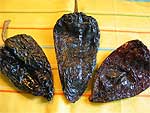By Cat, February 2009 (Photo, right, from Food.com) Includes: 1. About Chiles; 2. Texas Chili (with or without Beans) See also: 1. Cat’s Christmas Tree Chili; 2. Beans & Other Legumes: Soaking & Sprouting; 3. Chiles & Peppers (About)
I’m only beginning to learn how to use dried chiles, and I’ve not yet tried this recipe. Of course, if you can get fresh poblanos, use those instead of the dried Anchos. Dried New Mexico Chiles are another good substitute.
When I first started making chili, I used canned kidney beans, but in later years, I’d learned how to sprout and cook the dried beans. Now I like to use a mix of beans, including kidney and pinto, and whatever else interesting I can find.
I also like to use a fair amount of cayenne. I like it so hot it makes my eyes cross. Since I’ve not yet tried this recipe, I retain the amount from the original recipe.
In the winter, its hard to find good fresh tomatoes in the northern climes where I live, so I use reconstituted sun-dried tomatoes.
An excellent accompaniment for chili is corn bread, with lots of real butter and a bit of raw honey.
About Chiles
(Photo, left, from Wikimedia Commons)
Refer to The Cook’s Thesaurus (3, 4) for a great description, with pictures, of many different chiles, both fresh and dried. It also suggests reasonable substitutes if you can’t find a particular chile. See also Chiles & Peppers (About) on this site.
Wonder about the spelling: chili or chile? See the definitive article in the LA Times: Chili or Chile? Dispute Never Seems to Cool Off (5): “The Los Angeles Times spells the vegetable ‘chile‘ and the spicy soup ‘chili.’ The sauce made of chile, onion and tomato? ‘Chile sauce’.”
Texas Chili (with or without beans)
I found this recipe in the AARP magazine, by John Morthland (1). Narry a tomato nor bean in the original recipe; it’s more like a stew. I’ve added chopped fresh tomatoes as an optional garnish. And I’ve added instructions to add beans, if desired.
The original recipe calls for “fresh ancho peppers.” Anchos are the sweetest of the chiles. My friend Gayle tells me that anchos are actually dried poblanos. If you want them fresh, you have to buy poblanos; look for a green heart-shaped pepper, similar to Anaheim. (Refer to ‘Cooks Thesaurus links (3, 4), to see photos).
Serves 4 (or more if you add beans).
Ingredients & Equipment:
Beans (if using)
- ½ pound dried beans
- warm filtered water
- lemon juice (1 Tbsp per quart of water)
- ½ Tbsp olive oil
- 2 cloves garlic, peeled and crushed
- ¼ tsp Unrefined sea salt
Chili
- 1 fresh jalapeño pepper
- 1 fresh poblano pepper (or dried ancho)
- filtered water
- 1 ½ pounds lean chuck steak or roast (beef or buffalo)
- 1 ½ Tbsp olive oil (or 1 ounce rendered beef suet)
- 1 Tbsp cumin seeds
- ½ – 2 tsp cayenne pepper
- ½ tsp dried oregano, or more, to taste
- Unrefined sea salt, to taste
- 2 or more cloves garlic, chopped
- Chopped red onion or scallions, to taste
- Chopped fresh tomato (optional garnish)
- grated cheddar or Mexican cheese (optional)
- sour cream (optional)
Equipment
- cast iron dutch oven or 3-quart saucier
- broiler or direct flame
- small cast iron skillet
Method:
Soak & cook beans (if using)
- Cover beans with warm water. Stir in whey or lemon juice and leave in a warm place overnight (24 hours). The longer they soak, the shorter the cooking time. Check after a few hours and add more water as necessary.
- Drain beans, rinse and put in saucier or stock pot along fresh water to cover by 2 inches. Boil for 10 minutes (very important, to ensure soft beans, and to destroy a toxin in kidney beans) and skim.
- Add ½ Tbsp. olive oil and garlic. Simmer gently until beans are tender, 1 – 3 hours. Add more water as needed to keep beans covered.
- About 20 minutes before the beans are done, add about ¼ tsp of salt.
- At this point, you can keep going, or transfer beans and cooking liquid to refrigerator, to make the chili later.
Chili
- Dried chiles: see Chiles & Peppers (About) for how to prepare them.
- Fresh peppers: Char on all sides, in a hot cast iron skillet, under the broiler, or over a direct flame. Place them in a brown paper bag, to sweat. Peel off skins; remove stems and seeds.
- Puree prepared peppers in food processor or blender with just enough water to cover.
- Cut chuck steak/roast into ¼ inch cubes. Heat oil or suet in Dutch oven or saucier, then saute cubed meat until gray. You may need to do this in batches, to avoid crowding the cubes.
- Combine all batches of sauteed meat in pot. Add pepper puree, cover with 2 inches of water and bring to a boil. Turn heat to low and simmer for 30 minutes.
- Meanwhile, chop garlic. Dry-roast cumin seeds in hot skillet (without oil) until aromatic, then grind in a mortar.
- Remove from heat; add seasonings and garlic. Bring to a boil again, then turn heat to low. If using cooked beans, add now.
- Simmer, covered, 45 minutes, stirring occasionally. Add water, sparingly, if the meat sticks to the pot.
- Meanwhile, chop onion and tomato, and grate cheese.
- Optional: Let chili sit in refrigerator to congeal the fat, then skim it off. Reheat chili before serving.
Serving ideas
- Serve topped with chopped onion, tomato, grated cheese and/or sour cream.
References
- AARP Magazine, January/February 2009 issue
- Food.com photo: (food.com/library/ancho-chile-pepper-3)
- The Cooks Thesaurus: Dried Chiles (switcheroo.com/Chiledry.html)
- The Cooks Thesaurus: Fresh Chiles (foodsubs.com/Chilefre.html)
- LA Times on Chile vs Chile: articles.latimes.com/2000/nov/19/local/me-54396; also latimesblogs.latimes.com/readers/2011/10/chili-or-chile-peppers-spelling.html


